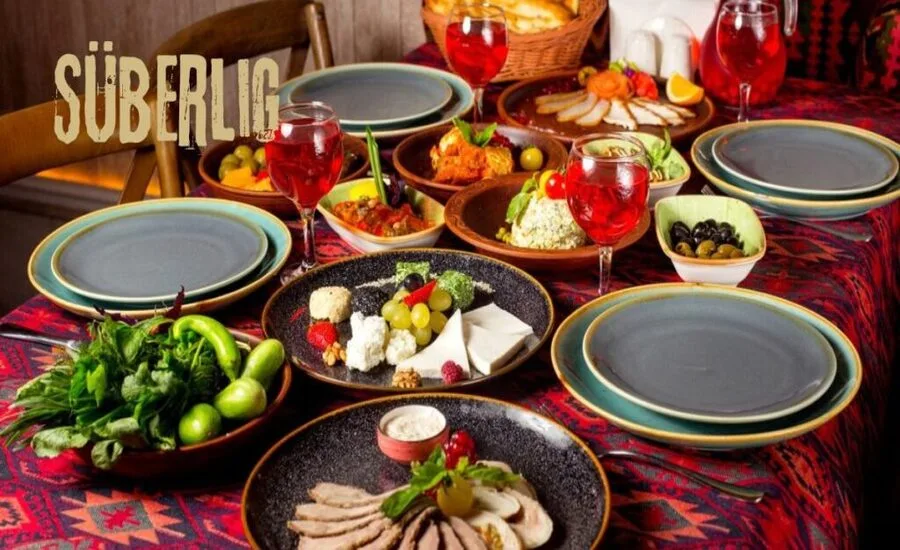Food & Drink
Exploring Süberlig: A Turkish Culinary Treasure

Turkish cuisine is renowned for its rich history, diverse flavors, and culinary techniques that span centuries. Among the many traditional dishes that have earned Turkey its place as a food lover’s paradise, Süberlig stands out as a relatively lesser-known, yet equally captivating, treasure. This unique dish, whose origins trace back to the heart of Turkey, is deeply rooted in the country’s history, culture, and agricultural practices. For those unfamiliar with Süberlig, it represents a dish that embodies the essence of Turkish hospitality, regional agricultural bounty, and a legacy of community cooking. In this exploration, we will delve into the history, ingredients, preparation techniques, and regional variations of Süberlig, while also examining its cultural significance and relevance in modern-day Turkish cuisine.
The Origins and History of Süberlig
Süberlig, much like many traditional Turkish dishes, has a deep connection to the land and its people. The dish’s name is derived from the Turkish word “sü”, meaning milk, and “berlik”, a term referring to a specific type of wild herb or green. Its name itself offers a glimpse into the simplicity and humble nature of the dish, which is traditionally made using fresh, natural ingredients that are abundant in Turkey’s rural regions.
The origins of Süberlig date back to the Ottoman Empire, where it was considered a staple food in the rural villages. It was especially popular among the shepherds and farmers of Anatolia, who would prepare the dish using locally available herbs and dairy products. The dish was known for its simplicity, relying heavily on the flavors of milk, yogurt, and wild herbs—ingredients that were easy to procure, yet offered a deeply comforting and nourishing meal. Over time, Süberlig became a regional specialty, particularly in parts of central and eastern Anatolia, and it was often made in large communal pots, reflecting the communal aspect of Turkish dining culture.
Historically, the dish also holds significance as a food prepared during times of celebration or community gatherings, especially in rural villages. It was a dish that brought people together, serving as both a meal and a symbol of hospitality. In recent years, Süberlig has experienced a resurgence in popularity, thanks to Turkey’s growing interest in preserving traditional culinary practices and regional dishes.
Key Ingredients in Süberlig
At its core, Süberlig is a dish built on a foundation of humble, locally sourced ingredients. The primary components of this dish include yogurt, wild herbs, and milk, with the addition of various grains and vegetables depending on the region and the cook’s preferences. The simplicity of these ingredients is what gives Süberlig its distinct, earthy flavor.
Yogurt:
The backbone of Süberlig, yogurt is used both for its tangy flavor and its creamy texture. In many rural Turkish households, yogurt is homemade, often made from the milk of sheep or cows. This yogurt imparts a rich, velvety texture to the dish and enhances its overall depth of flavor.
Milk:
Fresh milk is another key ingredient, contributing a smooth and delicate flavor to the dish. In some variations, the milk is used as a base for a soup-like consistency, while in others, it may be thickened to create a more substantial dish.
Wild Herbs:
One of the defining characteristics of Süberlig is the use of wild herbs, which are gathered fresh from the surrounding landscapes. These herbs can vary depending on the region but often include a variety of aromatic greens such as dandelion, thyme, oregano, and sage. The herbs infuse the dish with a natural, earthy flavor that balances the richness of the yogurt and milk.
Grains and Vegetables:
In some regions, Süberlig incorporates grains such as bulgur or rice, which provide added texture and heartiness to the dish. Vegetables like onions, carrots, and spinach may also be added, depending on the season and what is locally available.
Butter and Olive Oil:
Süberlig is often finished with a generous dollop of butter or a drizzle of olive oil. This adds richness and helps to bind the flavors together. In rural settings, butter made from the milk of local cows or goats is commonly used, adding a deep, creamy quality to the dish.

The Preparation of Süberlig
While the basic ingredients of Süberlig are simple, the preparation of the dish requires a certain level of skill and attention to detail, especially in ensuring that the balance of flavors is just right. The preparation method may vary slightly depending on the region, but the general approach remains the same.
Step 1: Preparing the Wild Herbs
The first step in making Süberlig is gathering the wild herbs. This is usually done by foraging in nearby meadows or forests, especially during the spring and summer months when the herbs are in full bloom. The herbs are washed thoroughly to remove any dirt or insects, and then they are chopped into small pieces.
Step 2: Cooking the Milk and Yogurt
In a large pot, the fresh milk is heated until it reaches a gentle simmer. Once the milk has warmed up, yogurt is gradually added, stirring constantly to ensure it does not curdle. The yogurt thickens the milk, creating a creamy base for the dish.
Step 3: Adding the Wild Herbs and Grains
Once the milk and yogurt have come together, the chopped wild herbs and any grains (such as bulgur or rice) are added to the pot. The mixture is simmered for a while to allow the grains to cook and the flavors to meld together. The herbs infuse the liquid with their aromatic properties, while the grains absorb the richness of the yogurt and milk.
Step 4: Final Touches and Serving
Once the Süberlig has reached the desired consistency, it is removed from the heat. The final step involves drizzling melted butter or olive oil over the top, which adds a silky smoothness and enhances the dish’s flavor. Süberlig is often served with a sprinkle of salt and freshly ground black pepper.
Regional Variations of Süberlig
As with many traditional Turkish dishes, Süberlig is not a dish with a single, fixed recipe. Over the centuries, various regions of Turkey have adapted and modified the dish to reflect local ingredients, agricultural practices, and tastes. Some of these regional variations include:
- Anatolian Süberlig: In central Anatolia, Süberlig is often made with a thicker consistency, and it may include additional vegetables such as carrots, onions, and even potatoes. The wild herbs are more varied in this region, with a particular emphasis on herbs like thyme and sage.
- Black Sea Süberlig: In the Black Sea region, the dish tends to be lighter, with more emphasis on the use of fresh greens like spinach and dandelion. It may also include the addition of rice or cornmeal to give the dish a unique texture.
- Aegean Süberlig: In the Aegean region, Süberlig often includes olive oil and a wider variety of vegetables. It may be served alongside seafood or grilled meats, reflecting the region’s Mediterranean influences.
The Cultural Significance of Süberlig
Beyond its delicious taste, Süberlig holds great cultural significance in Turkey. It is a dish that represents community and hospitality, often prepared for large family gatherings or social events. The process of foraging for wild herbs, preparing the ingredients together, and sharing the dish with others reflects the importance of family and togetherness in Turkish culture.
Süberlig also embodies the relationship between Turkish people and their land. The reliance on fresh, local ingredients and the use of wild herbs highlights a strong connection to nature and a reverence for the natural environment. In rural villages, the preparation of Süberlig is often a communal activity, with multiple generations coming together to share knowledge, food, and stories. This connection to tradition and the land makes Süberlig more than just a dish—it is a reflection of a way of life that values simplicity, sustainability, and the bonds of family.
Süberlig in the Modern Era
In recent years, Süberlig has seen a resurgence in popularity, not only in Turkey but also among food enthusiasts around the world. As interest in authentic, traditional cuisines grows, Turkish dishes like Süberlig are being rediscovered by younger generations. In urban centers like Istanbul and Ankara, modern variations of Süberlig are being served in contemporary restaurants, often with a creative twist that incorporates modern culinary techniques while maintaining the essence of the traditional recipe.
In a world where fast food and processed meals have become the norm, Süberlig represents a return to wholesome, home-cooked meals that are prepared with care and attention to detail. As more people seek out authentic, regional dishes that offer both flavor and cultural insight, Süberlig stands as a testament to the enduring power of traditional cuisine.
Conclusion
Süberlig is more than just a dish—it is a symbol of Turkish culture, history, and hospitality. With its humble ingredients, rich flavors, and cultural significance, it encapsulates the heart of Turkish home-cooking and the importance of community and tradition in the kitchen. Whether prepared in a rural village or served in a modern urban restaurant, Süberlig continues to bring people together, offering a taste of Turkey’s culinary heritage. As we continue to explore the world of food, Süberlig serves as a reminder of the timeless power of traditional dishes to nourish both the body and the soul.
FAQs:
What is Süberlig?
Süberlig is a traditional Turkish dish that combines yogurt, milk, wild herbs, and grains, creating a creamy and aromatic dish that reflects the rich culinary heritage of Turkey. It is typically made using fresh, locally sourced ingredients, and varies regionally based on available herbs and vegetables.
Where does Süberlig originate from?
Süberlig has its roots in rural Turkey, particularly in the central and eastern Anatolia regions. Historically, it was prepared by farmers and shepherds, using ingredients that were readily available in the wild, such as wild herbs and fresh dairy products. Over time, it became a dish that was commonly served during communal gatherings or celebrations.
How is Süberlig prepared?
The preparation of Süberlig involves heating fresh milk and yogurt together, then adding wild herbs and grains. The dish is simmered until the grains are cooked and the flavors meld together. It is typically finished with melted butter or olive oil before serving.
What makes Süberlig unique?
Süberlig stands out due to its use of wild herbs, which infuse the dish with earthy, aromatic flavors. It’s also a dish that represents Turkish hospitality, as it’s often prepared for large family gatherings or celebrations. The reliance on fresh, local ingredients and the communal nature of its preparation give it a unique cultural significance.
Can I make Süberlig at home?
Yes! Süberlig is relatively simple to make at home, especially if you have access to fresh milk, yogurt, and wild herbs. You can adjust the recipe based on what is available to you, including adding different vegetables or grains. If you’re unable to find wild herbs, you can substitute with commonly available herbs like thyme, oregano, or sage.
Is Süberlig served hot or cold?
Süberlig is typically served hot, especially in its traditional form, where the dish is enjoyed warm right after it has been cooked. However, it can be eaten at different temperatures depending on personal preference.

-

 Fashion8 months ago
Fashion8 months agoLiteroticaTags Explained: Find And Use The Top Tags For 2025
-

 BUSINESS9 months ago
BUSINESS9 months agoWhat is NippyDrive? A Complete Guide to Using NippyDrive
-

 Biography9 months ago
Biography9 months agoCoco Lovelock Bio, Age, Career, Net Worth, Height, Education, Boyfriend & More
-

 Biography9 months ago
Biography9 months agoWho Is Meow Miu? Get to Know the Latest Star in the Spotlight
-

 Fashion8 months ago
Fashion8 months agoWebfreen.com Fashion: Redefining Affordable Luxury
-

 Home Improvement8 months ago
Home Improvement8 months agoValvula Check 32mm Sodimac: Comprehensive Guide
-

 TECHNOLOGY7 months ago
TECHNOLOGY7 months agoTransform Text into Stunning Videos: Free Online AI Text-to-Video Generator
-

 BUSINESS6 months ago
BUSINESS6 months ago9 Packaging Trends You Can’t Afford to Ignore in 2025